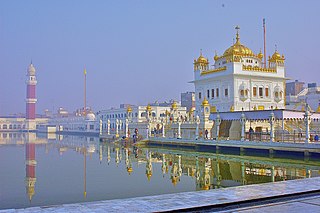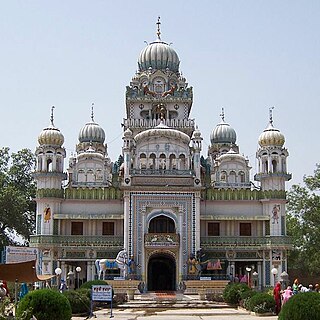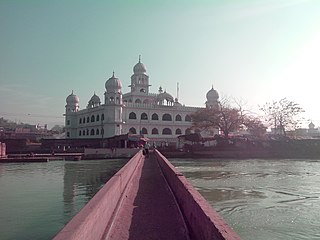The following outline is provides an overview of Sikhism, or Sikhi.

Gurdwara Sri Tarn Taran Sahib, officially Gurdwara Sri Darbar Sahib, is a gurdwara established by the fifth guru, Guru Arjan Dev, in the city of Tarn Taran Sahib, Punjab, India. The site has the distinction of having the largest sarovar of all the gurdwaras. It is famous for the monthly gathering of pilgrims on the day of Amavas. It is near Harmandir Sahib, Amritsar.

Tarn Taran Sahib is a city in the Majha region of the state of Punjab, in northern India. It is the district headquarters and hosts the municipal council of Tarn Taran district. Gurdwara Sri Tarn Taran Sahib, a prominent Sikh shrine, is located in the central part of the city.

Anandpur Sahib, also referred simply as Anandpur, is a city in Rupnagar district (Ropar), on the edge of Shivalik Hills, in the Indian state of Punjab. Located near the Sutlej River, the city is one of the most sacred religious places in Sikhism, being the place where the last two Sikh Gurus, Guru Tegh Bahadur and Guru Gobind Singh, lived. It is also the place where Guru Gobind Singh founded the Khalsa Panth in 1699. The city is home to Takhat Sri Kesgarh Sahib, the third of the five Takhts in Sikhism.

The Takht Sri Darbar Sahib Damdama Sahib, is one of the five takhts or Seat of Temporal Authority of Sikhism, located in Talwandi Sabo, near the city of Bathinda in Bathinda district of Punjab, India. At this place Guru Gobind Singh, the tenth Sikh Guru, prepared the full version of the Sikh scriptures called Sri Guru Granth Sahib in 1705. The other four Takhts are the Akal Takht, Takht Sri Keshgarh Sahib, Takht Sri Patna Sahib and Takht Sri Hazur Sahib.

Talwandi Sabo is a town and Municipal Council, in Bathinda District, Punjab, India. It is famous for being the town in which one of the five Takhts of Sikhism where Takht Sri Damdama Sahib. It is also famous for its Baisakhi, which is celebrated on the 13th of April every year. It is a major cultural, transportation and agricultural centre, located in the Malwa region of Punjab. It is near the Punjab-Haryana border.

Kesgarh Qila or Takht Kesgarh Sahib, alternatively spelt as Keshgarh Qila, is one of the five takhts of the Sikhs located in Anandpur Sahib in Rupnagar district of Punjab, India. It is located just 40 km from Rupnagar city, the district headquarters and 78 km from state capital Chandigarh. The fort is also called Takhat Keshgarh Sahib. This Gurdwara was one of the forts constructed by Guru Gobind Singh at Anandpur Sahib for the defense of the Sikhs. He spent his 25 years at Anandpur Sahib and, to protect the Sikhs from the Rajas of the Hill States and Mughals, began the construction of five defensive Qilas (forts) all around the town.

Fateh Singh, commonly referred to with honorifics as Baba Fateh Singh or Sahibzada Baba Fateh Singh, was the fourth and youngest son of Guru Gobind Singh.

Ajit Singh, also referred to with honorifics as Sahibzada Ajit Singh or Baba Ajit Singh, was the eldest son of Guru Gobind Singh and the son of Mata Sundari. His younger brothers were Jujhar Singh, Zorawar Singh and Fateh Singh, but they had been born to Mata Jito. He was killed in the Second Battle of Chamkaur along with his brother Jujhar Singh. His other two brothers, Zorawar Singh and Fateh Singh, nine and seven years old, respectively, were bricked alive at Fatehgarh Sahib on order of Wazir Khan, governor of Sirhind-Fategarh.

Jujhar Singh (Punjabi: ਸਾਹਿਬਜ਼ਾਦਾ ਜੁਝਾਰ ਸਿੰਘ, pronunciation: ; 9 April 1691 – 23 December 1704), the second son of Gobind Singh, was born to Mata Jito at Anandpur Sahib. This event is now celebrated on April 9 each year according to the Nanakshahi Calendar.

Parivar Vichora is a Gurdwara situated on the bank of the river Sirsa in India. This is where the 10th Guru of Sikh, Guru Gobind SIngh Ji's, family got separated.
Gurdwara Mata Sundri is considered to be one of the major historical Gurudwara of the Sikh; it is a landmark on the Mata Sundri road in the heart of Delhi. It is situated behind JP Nayak Hospital, the Gurudwara is a tribute to Mata Sundri, the wife of the 10th Guru – Guru Gobind Singh.

The Saka Sirhindor the Nikke Sahibzada Saka refers to the martyrdom (Shaheedi) of the two sons of Guru Gobind Singh, named Zorawar Singh and Fateh Singh. The two Sikh children are remembered as the Nikke Sahibzade. They are believed to have attained martyrdom on 26 December 1704 at the ages of 5(or 6) and 9 respectively. In remembrance of this occasion, the Shaheedi Jor Mela is organised annually at Fatehgarh Sahib Punjab, India, to commemorate the supreme sacrifice at the place of their martyrdom on the 24th to 26th December.

Gurdwara Mehdiana Sahib, also called the 'School of Sikh History' is a Sikh gurdwara located in the village of Mehdiana, just outside Mallha, near Jagraon in Ludhiana district, India.

Baba Jiwan Singh was a Sikh general and companion of Guru Gobind Singh.

Kiratpur, also known as Kiratpur Sahib, is a town, just 30 km from Rupnagar city in Rupnagar district of Punjab, India. The town is the location of the Gurdwara Patal Puri where many Sikhs take ashes of their deceased.

Bhai Nihang Khan was the zamindar ruler of a small feudal estate called Kotla Nihang Khan near Ropar in Punjab, Lahore Subah, Mughal Empire. He was a friend and follower of the tenth Sikh Guru, Guru Gobind Singh. The Guru and his associates frequently stayed with Nihang Khan, who often sheltered and provided succor to them in the period when they were facing persecution by Mughal forces. By way of faith and ethnicity, Nihang Khan was a Muslim Pathan.

Hazur Sahib, also known as Takht Sachkhand Sri Hazur Abchalnagar Sahib, is one of the five takhts in Sikhism. The gurdwara was built between 1832 and 1837 by Maharaja Ranjit Singh (1780–1839). It is located on the banks of the Godavari River at the city of Nanded in the state of Maharashtra, India.
Bhai Rupa is a town in the sub-division Rampura Phul and block Phul in the Bathinda district of the Punjab. It is part of Malwa region of Punjab which was granted town status in 2013. Geographically, it is bordered by Dyalpura Bhaika, Jalal in the north, Gumti Kalan, Selwarah in the west, Burj Gill, Dhapali in the south, Ghanda Banna, Chhana Gulab Singh Wala, Dulewala town in the east. The town is divided into 13 wards and 3 Pattis( Kangar, Saanji Patti 1 and Saanji Patti 2).




















